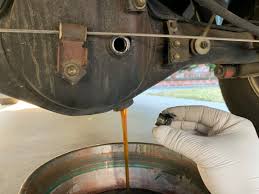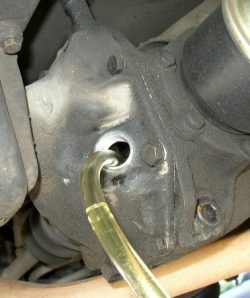What is Differential Fluid?
 Differential fluid is an oil that lubricates and cools the rotating components of a differential such as the ring & pinion gear, clutch packs and bearings. Without a lubricating fluid, the friction generated at the interfacing metal surfaces of a differential would heat up and wear the surfaces in a very short time leading to premature failure.
Differential fluid is an oil that lubricates and cools the rotating components of a differential such as the ring & pinion gear, clutch packs and bearings. Without a lubricating fluid, the friction generated at the interfacing metal surfaces of a differential would heat up and wear the surfaces in a very short time leading to premature failure.
In appearance, differential fluid, also known as gear oil, is an oil that appears thicker than engine oil. It comes in various versions depending on its application but can be generally categorized as synthetic and conventional.
What are the advantages of synthetic differential oils?
Synthetic oils have higher resistance to wear and temperature than conventional mineral oils. Although synthetic oils have a higher purchase price, they also have a longer service life and will not need to be changed as frequently. This reduces vehicle maintenance labor costs and reduces the amount of fluid and associated costs that needs to be disposed of. This is also an environmental benefit.

What are the disadvantages of synthetic differential oils?
Synthetic oils can thin out quick above a certain temperature. The differential temperature will vary depending on load such as towing or inclines. Thinning oil results in it losing its ‘cling’ ratio meaning it won’t adhere to the metal as well. This has clear implications in practical applications so the temperature the oil will be exposed to is a significant factor.
What is rear differential fluid?
Rear differentials are located at the rear of a vehicle and provide drive to the rear wheels. The rear differential usually contains the same differential fluid as the front transaxle in front-wheel-drive and all-wheel-drive vehicles.
How do I change my differential fluid?
Changing the differential fluid is a simple process you can do yourself and save labor costs on your vehicle.
- The first thing to do is look up what type of differential fluid you need and get some. If you don’t have your owner’s manual, you can ask your auto parts store and they should have a reference manual to look up the correct type and the right quantity. They may also be able to look up a replacement washer for the drain and fill plug, if either has one.
- If possible, put the car on an even surface and clean the area around the fill and drain plugs on the axle housing. This is to prevent any dirt getting into the axle housing when the plugs are removed. Any contamination that gets into the axle can potentially damage the differential so this should be avoided.

- Remove the fill plug followed by the drain plug and catch the used differential fluid in a wide topped container like a catch can. Be aware that gear oil is corrosive so wear gloves and don’t get any on your vehicle’s paintwork. It can also have a strong odor so you may want to change the fluid in a location with sufficient ventilation. If you have the equipment, you could alternatively use a fluid pump to remove the fluid from the differential however, it can be difficult to ensure you get the suction tube to the bottom of the differential housing.
- Once the fluid is drained, replace the washer (if one exists) and reinstall the drain plug using the correct torque value.
- Check the owner’s manual to find the fill line of the differential. In many cases, the differential is filled until the fluid reaches the fill hole. This is one reason it can be important to have the vehicle on an even surface. It is important to not overfill the differential or there will be too much pressure in the differential housing when the differential is rotating.

- Once filled, replace the washer (if any) and reinstall the filler plug with the correct torque.
- Final step, write down the mileage you changed the fluid and record it somewhere on or with the vehicle such as the owner’s manual. Otherwise, you will forget when it was changed and if you sell the vehicle, it is useful information for the next owner.
Replacing the fluid in a closed case differential
Closed-case differentials do not have a drain plug and require the rear housing to be opened in order to drain the fluid. This can be done by simply removing the fill plug and loosening the differential cover bolts. You may need to encourage the differential cover to come off the housing with some taps from a soft tool like a rubber mallet. Once a gap is opened, you can leverage the cover off but be careful not to damage the mating surfaces.
Once the cover is removed and the fluid is drained, you need to clean off the surfaces of the differential housing and the cover. You may need a blade to remove the remains of the gasket. Depending on the differential, you will either need to replace the gasket with a new one or make one with an appropriate tube of silicon designed to resist oil and heat. Run a bead around the perimeter of the mating surfaces and place the cover on. Torque the bolts to the factory spec and fill the differential with fluid.
No matter which method you use to replace the fluid, check for leaks before and after the first drive.
How often should differential fluid be changed?
The answer for this depends on the manufacturer’s recommended interval. You may find the recommended interval in your vehicle’s owner’s manual. However, the manufacturer’s interval is based on their recommended differential fluid also so using a differential fluid different from the OEM fluid could affect the change interval. Typical values range from 30,000 to 50,000 miles. Changing differential fluid is something that is often overlooked in vehicle maintenance. It is important to change the fluid as its effectiveness in cooling and lubrication breaks down over time leading to increased wear and premature failure. It costs much less to change the differential fluid more frequently than to replace a worn out differential.
What you need to know?
Although often overlooked in routine maintenance, differential fluid is of major importance in the correct operation of your differential. Without proper maintenance, the differential will fail prematurely which leads to an avoidable costly repair. Although this article may make differential fluid sound somewhat complicated, it doesn’t need to be. If you are unsure of how to maintain your axle or what differential fluid to use, contact Houston Rebuilt Axles for expert advice and professional differential rebuilding services.

